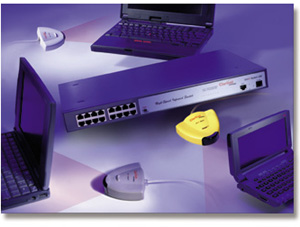IR Wireless LAN: a Flash in the Pan, or Viable Solution?
By R. Winn Hardin
Usually in the computing or the networking industry, getting a device standard that is supported by companies such as Microsoft Corporation (Redmond, WA) and Apple Computer (Cupertino, CA) and providing support for Windows 95/98, CE, Palm Pilot, Linux, and Apple portable devices is enough to guarantee a profitable market. However, despite the inclusion of infrared (IR) ports in almost every portable PC and Internet device since 1997, IR wireless LAN development has been almost nonexistent.
Clarinet Systems (San Jose, CA) hopes to change that in several select applications through the introduction of a family of devices that, along with shareware software, provides high-bandwidth Internet, LAN or WAN access through the IR port.

Clarinet Systems EthIR Beam and EthIR Switch devices provide IR transceiver and LAN/WAN access respectively for portable devices with internal IR ports. EthIR Beam uses an IR diode and photodiode to communicate with the portable device. This "free-space" communication system has a range of up to 1 meter and can transfer up to 4 Mbps based on the current Infrared Data Association (IrDA) standard.
Updated standards
Recently, the IrDA adopted a new standard that will provide 16 Mbps bandwidth. According to Clarinet Systems future generations of EthIR Beam and Switch devices will use this 16 Mbps standard.
Although the connection from the portable device or laptop to the Clarinet Systems device does not require cables, the EthIR Beam/EthIR switch/LAN connection does. The EthIR Beam transceiver connects to the RJ-45 ports on the EthIR Switch hub through standard Category 3 or 5 UTP 8-wire cable. The EthIR Switch—which can reside up to 100 meters from the EthIR Beam devices and be configured for either eight or 16 EthIR Beam ports—is then plugged into the LAN.
"If you already have a LAN card, we want you to think wireless before buying your next one. If you don't have a LAN card, we want you to think wireless before buying your first one," says Wen Chang, president and founder of Clarinet Systems. "And when you think wireless, think IR."
Targeting travelers
Clarinet Systems is marketing their systems to the hospitality industry (motels and hotels) where travelers need Internet and e-mail access, but may not have the right hardware or the technical savvy to reconfigure their machines between dial-up-connections and LAN networks. Company officials maintain that, many times, travelers may not have remembered to bring their PCMCIA cards or proper cabling to plug into the hotel's data infrastructure.
The Clarinet system instead places the onus on the facility, rather than the customer. The exception is the IR Connect software, a free shareware required by the portable device for IR communication. Other targeted markets include business, educational and hospital facilities where individual users will benefit from greater bandwidth than conventional RF systems. Conventional RF systems currently divide 2 Mbps of bandwidth among multiple users.
"IR is good for a very short range solution, but it has to be a very specific solution to use IR," says Rebecca Dircks, wireless LAN analyst with Cahners In-Stat Group (Newton, MA). "It was primarily envisioned as a connection for laptops and printers, but many printers don't have [the IR port…Also], IR is an individual solution, not a work group solution and most company's are looking for a work group solution."
Works best for individuals
Like most networking technology, however, the devils in the details. In Clarinet's hotel example, the devices make sense because logic dictates that only one person will access the data port at a time. For more than one person to simultaneously access the system, requires a separate EthIR Beam transceiver, reducing the cost-affordability argument made by Clarinet Systems that using the EthIR devices eliminates the cost of buying multiple network interface cards or PCMCIA cards for both LAN and wireless LAN systems.
Cost comparisons show that the cost of one EthIR port is slightly higher than a hardwired LAN port, but significantly less than setting up one RF port on a wireless LAN. If the application will accommodate user access one at a time, the EthIR solutions become even more cost effective because it does not require the purchase of additional network interface cards as conventional and RF LANs do.
The Bluetooth challenge
Perhaps the greatest challenge Clarinet Systems faces is a new wireless standard that is now just appearing. Virginia Brooks, an analyst with the Aberdeen Group (Boston, MA), believes the Bluetooth standard will likely supercede the use of IrDA-based communication.
"Customer's have been interested in this [IrDA ] because it's been the only option available in a built-in capacity. The distance isn't a whole lot better [10 to 100 meters with Bluetooth], but I think the industry momentum is behind that as a local-connection technology," she says.
Conceived in 1998, Bluetooth technology is designed to eliminate the cables needed to connect mobile communication devices, mobile computers, and peripherals. Bluetooth technology will enable users to connect their mobile computers, digital cellular phones, handheld devices, network access points, and other mobile devices through a short-range 2.4 GHz radio link.
The first specification for Bluetooth was released in July of this year. A variety of Bluetooth products will hit the market late this year and early next year. Companies, such as IBM Corp. (Armonk, NY), Nokia (Espoo, Finland), and Toshiba (Tokyo), are all working on solutions that employ the Bluetooth specification.
Since its inception, Bluetooth has gained a great deal of steam in the wireless industry. In a recent report, Allied Business Intelligence (Oyster Bay, NY) predicts that Bluetooth sales may exceed $2 million by 2005.
Founded in 1997, privately held Clarinet Systems Inc., provides wireless network access systems linking portable devices to the Internet, LAN and WAN using infrared technology. For more information contact: 408-501-0250, ext. 300 or info@clarinetsys.com
